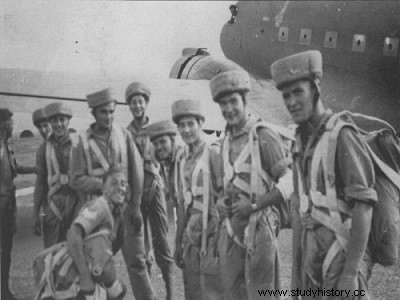
Chaklala, in the suburbs of Rawalpindi. New decor. Mountains and hills bare or covered with sparse vegetation, villages with terracotta houses and flat roofs, dry rivers, sky, heat, climate, noises, smell, all this atmosphere of Central Asia is very close to that which some of us have known near Fez or Oudjda.
To the north, the first foothills of the Himalayas and the green valleys of Kashmir.
To the west, the mountainous regions of the Pathans, the road to Kabul, the Khaïber pass, Rawalpindi, the charming "cantonment", the wide avenues lined with eucalyptus.
On the plain, a huge Royal Air Force field.
This is where every day a van, marked with the sign of the mongoose, drops us off for our parachute training. Every morning, cross-country, "roll-and-roll" sessions, harness sessions, slides, jump tower, visit to the folding and drying workshops, lunch under the tent at the R.A.F. In the afternoon, we start again:rolls, slides, harnesses... Twist! turn... more rolls, practice jumps, Action stations... go!... Next to us, a brigade of Indian paratroopers, led by the general, does the same rolls. The British use a single parachute. There is no emergency chest strap. The parachute always opens. And if it doesn't open, you always have the option of going to the storekeeper to ask for another...
And then, after a fortnight or three weeks of rolling around and maneuvering with harnesses, here we are embarked on a Hudson bomber. Kashmir lies to our right. Just under the device, a sort of mosaic of terrain cracked by drought, small white cubes which are houses, a large greenish square which is the drop zone. Sitting behind the pilot, on the slide, we see the landscape pass under our feet. A red lamp:Action station. A green lamp:Go.
A friendly push from the dispatcher... and we are in the void, spinning and gripped by an incredible silence. We float in the air. We are brought back to reality by the gigantic megaphones of our instructors ashore:“Join your legs, twist! twist! »
Measuring the swing as we have been taught, we pull on the cords... and we find ourselves sitting on the ground in the middle of what seems to us a prodigious tangle of silk and ficelles.
The following days, we familiarized ourselves with the technique of preparing the drops, setting up the lights, the signals, the choice of a dropping zone, the safety to be ensured, the handling containers of equipment... and we continue our jumps, in "Dakota", to teach us how to get out, not through a slide, but through the door. There is nothing difficult, you just have to put your foot forward... in the void. And we jump at night... and we jump as fast as possible... but we cannot wear the prestigious blue wings because we have not yet jumped "in operation" and, in any case, no one must knowing that we are paras..
.
All trainees are now transported to yet another different setting. In the middle of the Western Ghats, at the height of Goa, buried in the middle of thick forest massifs, small straw-topped bamboo huts shelter our group. We are here for the jungle course, getting used to the big forest. No horizon, everywhere thick thickets and high forests launching an assault on the hills. Trees fall, meander, creepers intertwine. The floor is covered with prickly rattan. In the valleys of the torrents, bushes of tall bamboo with long rigid thorns form real "seas" where you can only move on all fours... and tearing your clothes. The sun barely pierces through the foliage. No landmarks.
No view from the top of the trees, only other hills covered with the tropical forest which follow one another endlessly, it seems. In the clearings, or on the edge of the few rare villages of this "reserve", along the few larger rivers, birds, parakeets, game. Inside the forest, no noise, no flowers, hardly any birds.
We started by cutting bamboo, splitting it and flattening it. The hurdles made in this way serve us as a floor, walls, under the roof. We assembled the beams and rafters with vines and collected armfuls of “elephant grass” for the roof.
The clearing of a bamboo is an exhausting business. The massif includes about ten stems with long sharp thorns, all intertwined with each other, from the ground up to thirty meters in height. Once the bamboo is cut with a cutter, the Burmese dah, it does not fall. We can pull, push, nothing to do. You have to cut the whole clump. The slightest misstep is dangerous, shards of bamboo cut deeply and, in this climate, become infected.
